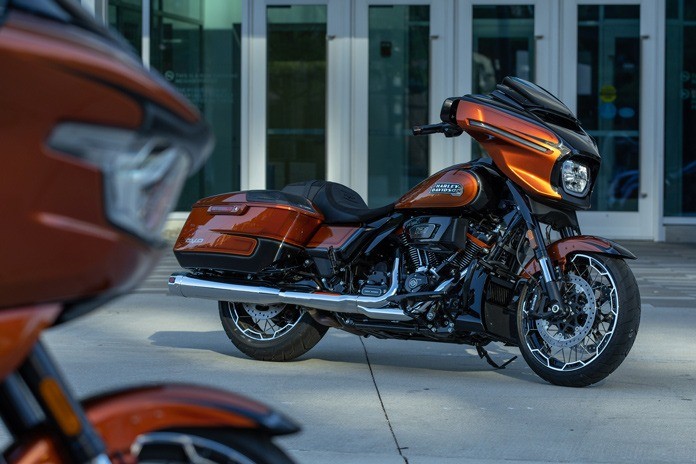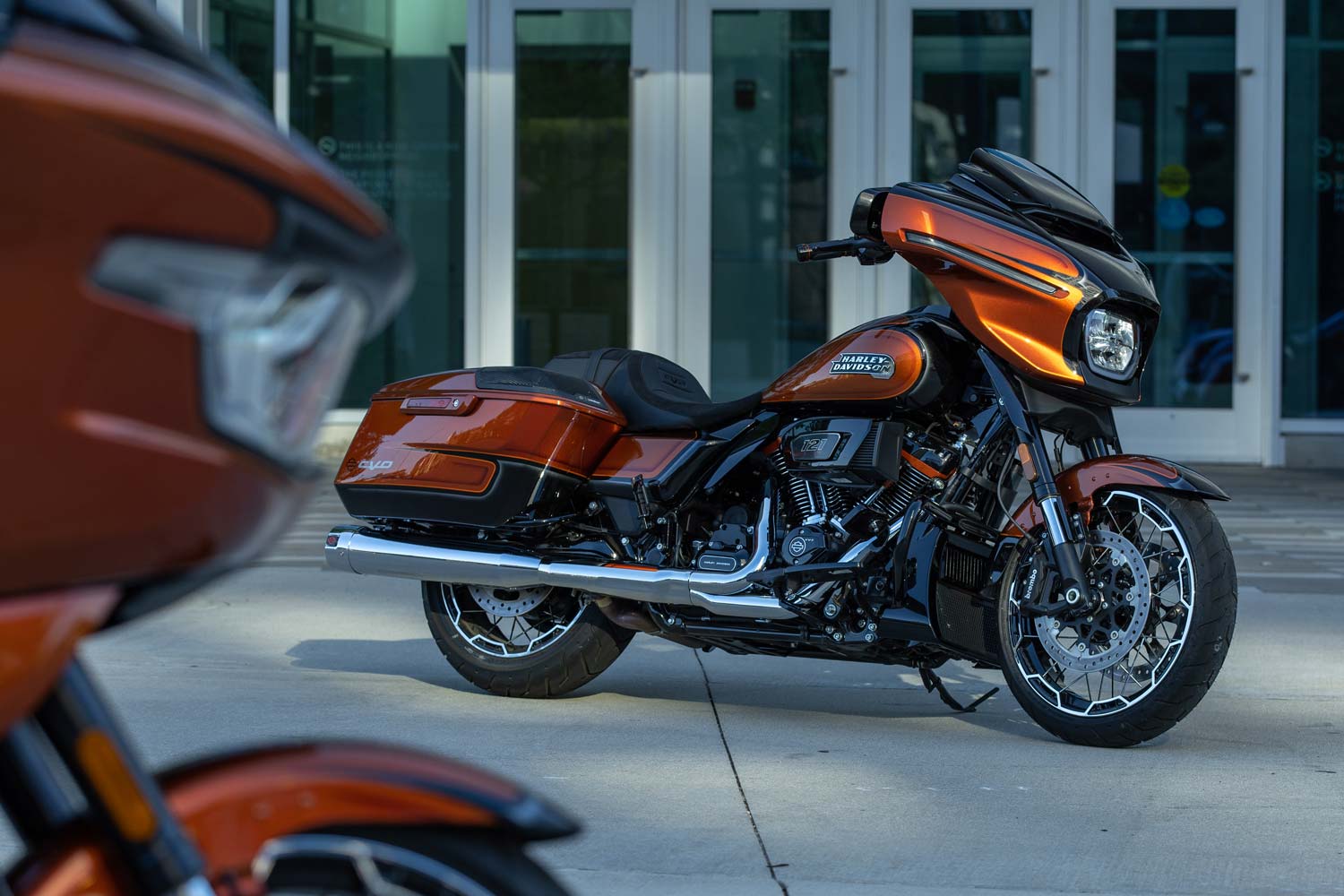The first issue of Thunder Press dropped in April of 1992. As with the magazine’s name, much has changed in our two-wheeled world since then. The 1990s were an ascendant decade for Harley that started the rise to a level of success in the aughts that may not be seen again.
Despite that tremendous growth, Harley-Davidson motorcycles were hardly state-of-the-art. They were relatively slow and featured archaic suspensions and flexible frames. In ’92, I bought a new FLHS. It took nearly a thousand dollars of carb, cam, and head work to give it decent performance.
These issues didn’t seem to matter to buyers (including myself), as sales records were continually set, peaking in 2008 at 344,000 units, up from only 48,000 in 1991. This growth brought significant change to dealerships, with most of the “mom-and-pop” stores being replaced by large, often gaudy edifices mandated to be located near freeway off-ramps.

The sales tide that raised the Harley boat also lifted the entire motorcycle industry. The times were good – until they weren’t. The housing market crash of 2007-2008 put an end to the moto industry’s growth.
Present-day Harleys are certainly state-of-the-art and are the most competent machines that the company has built. Recent redesigns of Harley tourers have brought their look to contemporary levels. Things should be booming. But they are not, nor are they for most of the industry. Harley sold 162,771 motorcycles in 2023, the lowest total since 1999.
See our Harley-Davidson motorcycle reviews here
Indian Motorcycle rejoined the marketplace in 1999 after 46 years of being passed between various entrepreneurs, but it was out of business by 2003. It did not become a viable manufacturer again until the brand was purchased by Polaris Industries in 2011. In 2021, Indian sold a record 36,600 motorcycles; the 2023 total was about 30,000.
See our Indian motorcycle reviews here
Despite the doom and gloom of the current state of the industry, I’m optimistic about Harley’s future. It has the design and engineering talent and the production capability – not sure about marketing. What it seems to lack is direction. Just what do you wanna be when you grow up, Harley?
The easiest route would be to become a boutique manufacturer of high-end motorcycles. The CVOs are an excellent example of this: beautiful and expensive, with large profit margins. That would probably sit well with the stockholders; to me, it’s a cop-out. I want to see the Motor Company build motorcycles for all of us.
This raises the uncomfortable subject of smaller, entry-level motorcycles. Harley has failed at this several times. The MoCo believes its motorcycles will sell as long as they say “Harley-Davidson” on the tank. This belief has been proven false. The most egregious example is the 500cc and 750cc Street models, available from 2014 until 2021. These motorcycles were heavy, slow, and of marginal quality.
The Harley name denotes large, big-motored motorcycles. As I’ve mentioned in previous columns, a small bike line from Harley needs to have a unique brand name. My suggestion remains: “Sprint, by Harley-Davidson.”
Related: Harley Turmoil: DEI and Overseas Production
One bright spot in the current motorcycle market is the adventure-bike segment, particularly the 600-900cc sizes. A couple of years back, Harley hinted at a 975cc version of its 1,250cc Pan America, but we’re still waiting for that to surface. As a fan of ADVs, I’d like to see this happen, but Harley should price it very carefully. The big Pan America has been popular but, according to some of my regional H-D dealers, has suffered from some electronic-related glitches.
As an old curmudgeonly dude, it’s easy for me to criticize, but it’s evident that things are not going all that well in Milwaukee. On the other hand, Harley has weathered similar storms in its 120-year history.
Find more Unrepentant Curmudgeon columns here


















What people will have to accept is that a Harley has to be more than an updated Knucklehead. The Sportster was Harley’s interpretation of a British twin, Unit construction and all. Being a boutique brand is a nice idea but now that people can buy another American V-Twin (Indian) for less money will make that hard. It will stick in their craw but importing the Chinese 500 and 350 Harleys and sticking with it can only help. The new riders they’ll attract will neither care or know where they are built only that it says Harley on the gas tank.
In typical American fashion price, size and weight have been super-sized by Harley Davidson. The American buying public craved these over-indulgences at one time. That time has passed. Us 60 and 70 Somethings will be phasing out of the bigger-is-better arms race. The new soldiers of the highway dont have the money or skills yet to jump onto a 30 grand, 900 lb road tank. HD shouldn’t be listening to their current customer base because we will all be dead or unable to ride within the next decade. HD should pay attention to the market trends and develop a real home-grown mid sized machine that’s affordable for newbies. Not a rebadged Chinese wannabe. Idiots.
After the failure of the 500 and 750 Street models it would appear that Harley doesn’t have the skill to build anything but 850 pound, $40,000 bikes. This attitude that anything the doesn’t have an improved Knucklehead engine in it is for girls has stopped sales in its tracks. They have to get better bikes from somewhere.
I rode several bike events this year and you know how many new Sportsters and Panamericas I saw out of a thousand motorcycles? One Panamerica.
The bottom line doesn’t care what they sell. Only that they create profit and give entry level riders a starting point. How many Harley riders started out on 250 Rebels? It’s not a wannabe, it’s accepting globalization. Even BMW sells bikes and scooters built in China and India.
The CEO and the board of directors need to go.
why put the blame on them…The entire company needs help if they are to continue into the next 20 or so years
Harley is in a tough spot. The MoCo came out with the Tri Glide to appeal to the aging baby-boomers who couldn’t or wouldn’t straddle a heavy machine. There are those who love the vintage styling, others want a more modern look that still is appealing, visually. For this rider, I have left Harley because of their lack of direction. The CEO really needs to be fired and replaced by a person who truly understands the heritage of this American company. Is it really that difficult to offer a middleweight bike that has decent performance, aesthetics and a realistic price tag that won’t require a purchaser to take out a second mortgage?
Here is my .02 I was in the Industry for over 25 years and saw Harleys peak in the 90s, selling $3000 to $5000 over MSRP and selling them long before the bikes were even delivered, the greed of dealerships, Harley Building new facilities and forcing dealers to build special stores and the struggles after the 2008 crash, I do blame Harley for overproducing motorcycles and diluting their own market.
Another factor is there aren’t as many people coming into the game, I myself have considerably slowed down and found new recreational hobbies. Having said that I really like the “new” sportsters If you haven’t driven one yet you should, test drives are always encouraged. I also like the Pan America, Harley has done an excellent job of building an adventure touring motorcycle (barring the growing pains).
Killing the air-cooled Sportster in the U.S. just because it couldn’t meet Euro 5 emissions was a real bad idea. That water cooled thing they have tried to replace it with is hideous.
Harley should eliminate the Street series and bring back the Dyna, with both large and small displacement models. Also, following the company’s failed DEI initiative, they should replace CEO Zeitz and whoever heads up the Marketing team. Clearly, they do not understand the company’s core customers. DEI worked so well for Budweiser after all, what could possibly go wrong?
Yes Harley had an awesome mid-size bike called the Sportster. 883 to 1200 cc’s. There is a reason why it was around for over 60 years, people liked it and could afford it. Yes by all means let’s bend the knee to Europe and their BS regulations. And the company’s own woke CEO and board of directors. Willie, help!